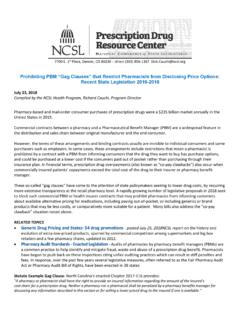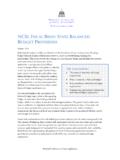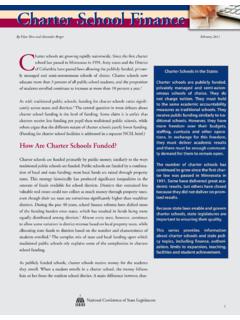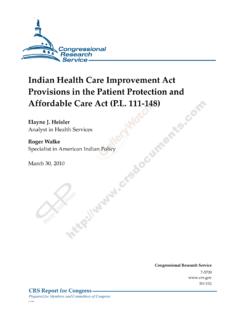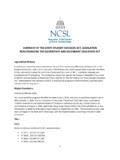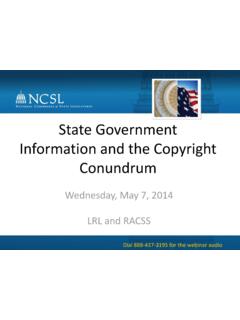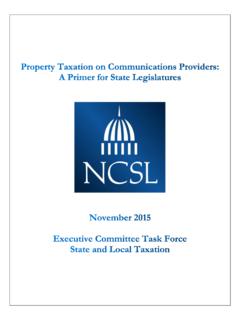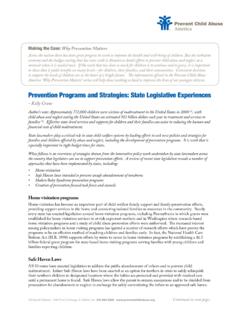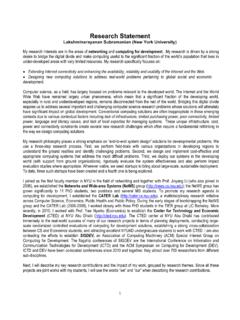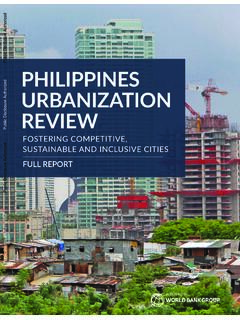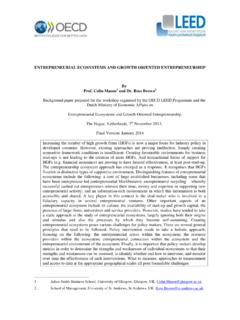Transcription of The American Rescue Plan Act Provisions
1 MARCH 10 | 2021 The American Rescue plan Act ProvisionsWHAT IT MEANS FOR STATESThe latest COVID-19 relief package provides $ trillion in mandatory funding, program changes and tax policies aimed at mitigating the continuing effects of the pandemic. The American Rescue plan builds upon previously enacted aid measures in 2020: The year-end spending and aid package. The Coronavirus Aid, Relief, and Economic Security (CARES) Act. The Families First Coronavirus Response Act (FFCRA). Please see below for a summary of Provisions of interest.
2 State and local Aid Provides $350 billion to help states, counties, cities and tribal governments cover increased expenditures, replenish lost revenue and mitigate economic harm from the COVID-19 pandemic. State and local government recipients could use the funds to cover costs incurred by Dec. 31, 2024. The funds would be distributed in two tranches, with 50% delivered no later than 60 days from the date of enactment, and the remainder delivered no earlier than one year later. States would have to distribute funds to smaller towns within 30 days of receiving a payment from the department.
3 States that miss the deadline would have to pay back any undistributed funds. A town cannot receive more than 75% of its budget as of Jan. 27, 2020. The Treasury Department could also withhold up to half of a state or territory s allocation for as long as 12 months based on its unemployment rate and require an updated certification of its funding needs. Provides $ billion to states and the District of Columbia: $ billion would be equally divided to provide each state a minimum of $500 million. $169 billion would be allocated based on the states share of unemployed workers over a three-month period, from October-December 2020.
4 Provides $ billion to local Governments: $ billion for counties. $ billion for metropolitan cities. $ billion for towns with fewer than 50,000 people. Provides $ billion to territories. Provides $20 billion to tribal governments. Provides $10 billion for a Coronavirus Capital Projects Fund to carry out projects to support work, education and health monitoring during CONFERENCE OF STATE LEGISLATURES2 Use of funds: Respond to the COVID-19 emergency and address its economic effects, including through aid to households, small businesses, nonprofits, and industries such as tourism and hospitality.
5 Provide premium pay to essential employees or grants to their employers. Premium pay couldn t exceed $13 per hour or $25,000 per worker. Provide government services affected by a revenue reduction resulting from COVID-19. Make investments in water, sewer and broadband infrastructure. State and local governments cannot use the funds towards pensions or to offset revenue resulting from a tax cut enacted since March 3, 2021. State and local governments could transfer funds to private nonprofit groups, public benefit corporations involved in passenger or cargo transportation, and special-purpose units of state or local Payments to Citizens Provides another round of direct payments of $1,400 for individuals, $2,800 for joint filers, and $1,400 for each qualifying dependent.
6 Dependents would include full-time students younger than 24 and adult dependents. The payments would begin to phase out for individuals with an adjusted gross income (AGI) of $75,000 ($150,000 for couples) and would be zero for AGIs of $80,000 ($160,000 for couples) or more. Heads of households will receive the full amount if they earned up to $112,500, and it will phase out completely at $120,000. Payments would be based on 2019 or 2020 tax returns. The Treasury Department could provide payments to individuals who have not filed based on return information available to the Provisions Earned Income Tax Credit: Raises the maximum Earned Income Tax Credit (EITC) for adults without children from $543 to $1,502.
7 It would also lower the age eligibility for the childless EITC from 25 to 19 and eliminate the upper age limit, which currently bars the credit for childless people age 65 and older. Other changes include eliminating a rule that bars individuals who have children without Social Security numbers from claiming the childless EITC and allowing individuals who are separated from their spouses to claim the EITC on a separate return if they live with their child for more than half of the year. Child Tax Credit: Increases the Child Tax Credit maximum amount to $3,000 per child and $3,600 for children under age 6.
8 It would also extend the credit to 17-year-olds. The increase in the maximum amount would begin to phase out at $150,000 in income for married couples, $112,500 for heads of households and $75,000 for other parents. Other changes to the Child Tax Credit include making it fully refundable, meaning the entire credit could be provided as a refund if it exceeds an individual s income tax liability, instead of partially refundable under current law. Dependent Care: Temporarily increases the value of the child and dependent care tax credit, which currently covers 35% of care expenses up to $3,000 for one dependent or $6,000 for two or more dependents.
9 The measure would make the credit refundable, increases the maximum allowable expenses to $8,000 for one dependent and $16,000 for two or more, and allows the credit to cover 50% of expenses. NATIONAL CONFERENCE OF STATE LEGISLATURES3 Employee Retention Credit: Extends the employee retention credit established by the CARES Act through Dec. 31, 2021. The measure also would expand eligibility for the credit to new startups that were established after Feb. 15, 2020, and companies if their revenue declined by 90% compared to the same calendar quarter of the previous year.
10 The credit would be capped at $50,000 per calendar quarter for startups. Paid Leave Credits: Extends tax credits for employer-provided paid sick and family leave established under the Families First Coronavirus Response Act through Sept. 30, 2021. The measure would also increase the wages covered by the paid family leave credit to $12,000 per worker, from $10,000; cover as many as 60 days of paid family leave for self-employed individuals, instead of 50; and bar employers from receiving credits if their paid leave favors highly compensated employees, full-time workers, or employees based on tenure.
